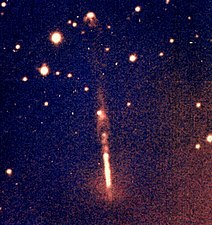HH 111
| Emission nebula | |
|---|---|
| Herbig–Haro object | |
 Hubble WFC3 image of HH 111 | |
| Observation data: J2000.0 epoch | |
| Right ascension | 05h 51m 44.2s[1] |
| Declination | +02° 48′ 34″[1] |
| Distance | 1500[2] ly |
| Constellation | Orion[2] |
| Designations | HH 111 |
HH 111 is a Herbig-Haro object in the L1617 dark cloud of the Orion B molecular cloud[2] in the constellation of Orion. It is a prototype of a highly collimated optical jet sources. It shows several bow shocks and has a length of about 2.6 light-years (0.8 parsec).[3]
HH 111 is about 1300 light years (400 parsec) distant from earth and the central source is IRAS 05491+0247, also called VLA 1.[2] This source is the driving source of the jets and it is a class I protostar with a luminosity of about 25 L☉. This protostar is embedded in a 30 M☉ cloud core.[4] The dynamical age of the complex is only 800 years.[4] Near the central source an ammonia feature called NH3-S was found, which is a starless core with a turbulent interior induced by HH 111.[2]
The jets move with a speed of 300 - 600 km/s and consist of a blueshifted component, which is bright in optical wavelengths and a redshifted faint counterjet.[4] A second pair of bipolar jets, called HH 121 was discovered in the near-infrared at an angle of 61° compared to the HH 111 pair. This was taken as evidence for a system with multiple protostars.[5][6]
Gallery
[edit]-
The bright blueshifted jet of HH 111 seen by the ground-based telescope NTT
-
HH 111 seen by the Spitzer Space Telescope in infrared, showing also HH 121
-
Animation of HH 111 (Hubble image), showing the movement of the jet and bow shock
References
[edit]- ^ a b "HH 111". SIMBAD. Centre de données astronomiques de Strasbourg. Retrieved 2020-03-04.
- ^ a b c d e Sewiło, Marta; Wiseman, Jennifer; Indebetouw, Remy; Charnley, Steven B.; Pineda, Jaime E.; Lindberg, Johan E.; Qin, Sheng-Li (November 2017). "Very Large Array Ammonia Observations of the HH 111/HH 121 Protostellar System: A Detection of a New Source with a Peculiar Chemistry". Astrophysical Journal. 849 (1): 68. arXiv:1709.04856. Bibcode:2017ApJ...849...68S. doi:10.3847/1538-4357/aa8b18. ISSN 0004-637X. S2CID 56018036.
- ^ Reipurth, Bo (July 1989). "The HH111 jet and multiple outflow episodes from young stars". Nature. 340 (6228): 42–45. Bibcode:1989Natur.340...42R. doi:10.1038/340042a0. ISSN 0028-0836. S2CID 4348316.
- ^ a b c Reipurth, Bo; Raga, A. C.; Heathcote, Steve (June 1992). "Structure and Kinematics of the HH 111 Jet". Astrophysical Journal. 392: 145. Bibcode:1992ApJ...392..145R. doi:10.1086/171413. ISSN 0004-637X.
- ^ Reipurth, Bo; Yu, Ka Chun; Rodríguez, Luis F.; Heathcote, Steve; Bally, John (December 1999). "Multiplicity of the HH 111 jet source: it Hubble Space Telescope NICMOS images and VLA maps". Astronomy and Astrophysics. 352: L83 – L86. Bibcode:1999A&A...352L..83R. ISSN 0004-6361.
- ^ "Hubble Finds Young Stars in Cosmic Dance". HubbleSite.org. Retrieved 2020-03-04.



